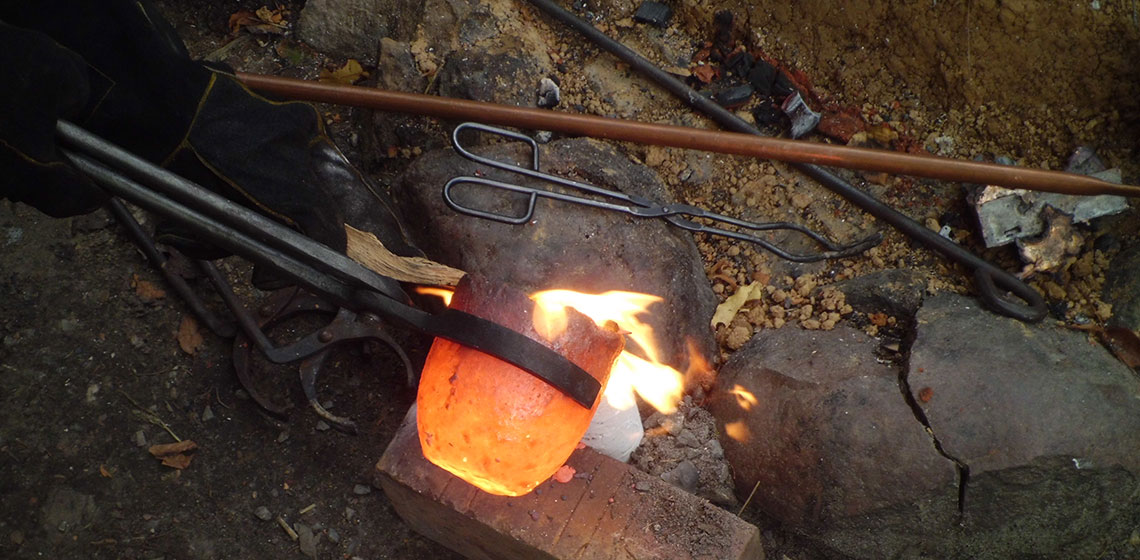
A recent conference, funded partially by UISPP, was held in Queens University Belfast. While its main focus was on Bronze Age metalsmithing tools and assemblages, the MeTools conference (23-25 June at Queen’s University, Belfast) had several presentations that focussed on experimental archaeology as a means of exploring metalworking craft.
The conference commenced with a keynote speech and a four hour masterclass, presented by Professor Barbara Armbruster (Université de Toulouse). She spoke about the history of research in recreating ancient metalworking techniques and her exploration of early technology, including her apprenticeship to a goldsmith in Mali. This set the tone for an appreciation of the next couple of days’ speakers, whose research had employed experimental archaeology to test their various hypotheses.
Mechtid Freudenberg and Leif Glasser (Stiftung Schleswig-Holsteinische Landesmuseen, Germany) related how they had replicated an axe found at Ahneby, Schleswig-Flensburg, in order to understand its manufacture and subsequent modification by forging to sharpen the blade. The surface voids that had been filled with tin were of special interest - small lumps of tin were hammered into deliberately-produced cavities in the experimental axe to replicate those on the original. This particular experiment was unsuccessful, highlighting the need for further research to understand the process by which the tin was introduced to the surface voids on this axe.
Verena Leusch (Curt-Enghelhorn Centre for Archaeometry, Mannheim, Germany) and Miljana Radivojević (University of Cambridge, UK) presented the results of replicating a clay- lined hearth that had been used for copper smelting in the Balkans. The slag produced during their experiments matched that of the slag found at excavation sites associated with the Vinča and Karanovo settlements. They noted that all of the tools found at the site could have been used for both metalworking or for other tasks, indicating that the tools we normally associate with metal-working could be multi-functional.
The next paper that included experimental archaeology was presented by Andreas Svensson (University of Lund, Sweden). The project, From Crucible and onto Anvil explored the use of multiple metals and the organisation of work space during the Early Iron Age. His research challenges the interpretation of many open-air museums, where ferrous metalwork is not performed alongside non-ferrous metal. The analyses of metallurgical debris from various sites in Scandinavia indicate that this is not the case and that during the Late Iron Age, metalsmiths worked in a variety of metals.
During the Friday afternoon session, Justine Vernet and Paolo Piccardo (Università degli Studi di Genova, Italy) presented a paper on the effect of different mould materials during casting. They cast bronze ingots in moulds of sand, clay, and modern steel to compare the cooling rates and how the mould material affected the microstructure of the metal. The experiments provided evidence of a link between the microstructure and the different mould materials, which could be compared to prehistoric bronze castings.
Saturday’s presentations began with a session on tools and workshops. The day began with Brian Clark, a jeweller and metalsmith who has mastered Bronze Age forging and forming techniques. He demonstrated the tools and techniques he uses to recreate ribbon and flanged torcs, lunulae, and beaded wire using replica Bronze Age tools. Later in the day he brought out examples of his work and displayed the tools he used to make them. He was followed by Professor Barbara Armbruster, who spoke in more detail about her work with ancient tools and workshops, along with the contexts in which tools are found throughout Europe. This was also combined with her ethnographic work in Mali that provided new insights about the location and physical structure of early workshops.
In addition to the papers, a number of posters were displayed. Bridget Schorer (Landesmuseum Würtemburg, Germany) presented a poster on the tools and techniques used for embossing gold objects during the Early Iron Age, and Alessandro Armigliato (University of Bologna, Italy) displayed the results of his work using experimental bronze casting pits.
The MeTools Conference provided a meeting place for people interested in the tools and technology of early metalsmiths. It was shown how experimental archaeology was invaluable for comparing microstructure, wear, and for exploring production techniques. The presenters were congratulated by the conference chairs for their systematic approaches to experimental work. A publication of the papers presented at the conference is planned for next year.
For more information please contact Linda Boutoille.